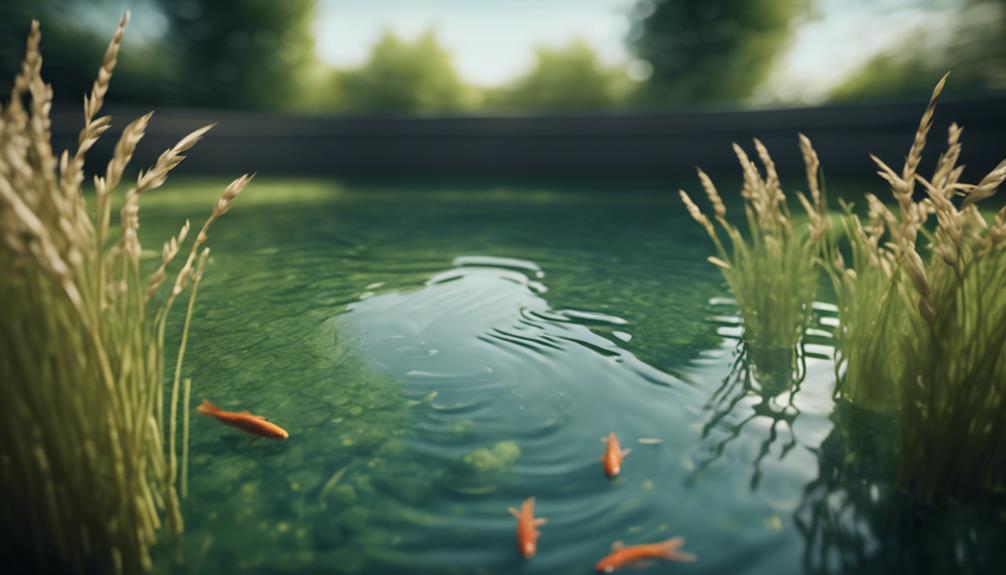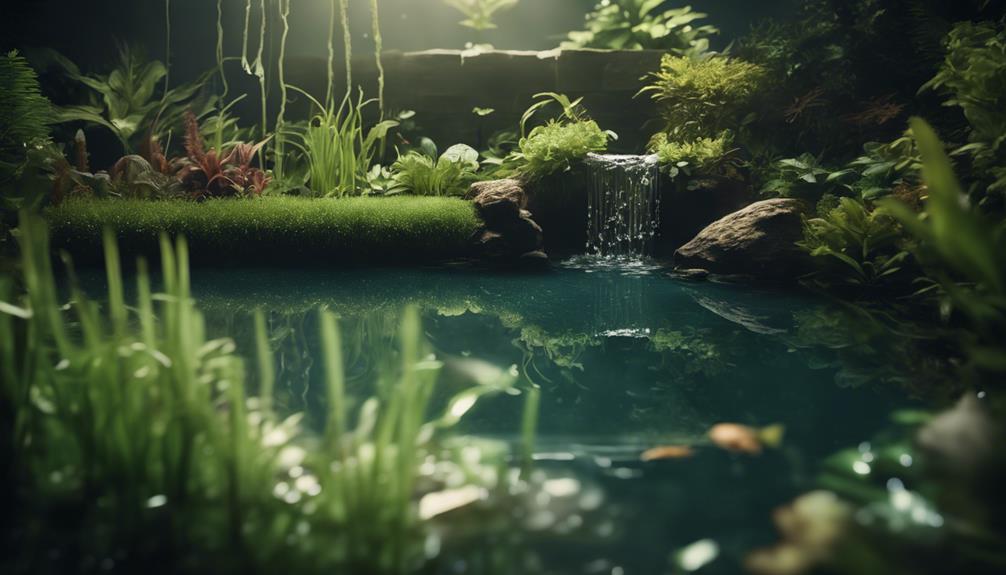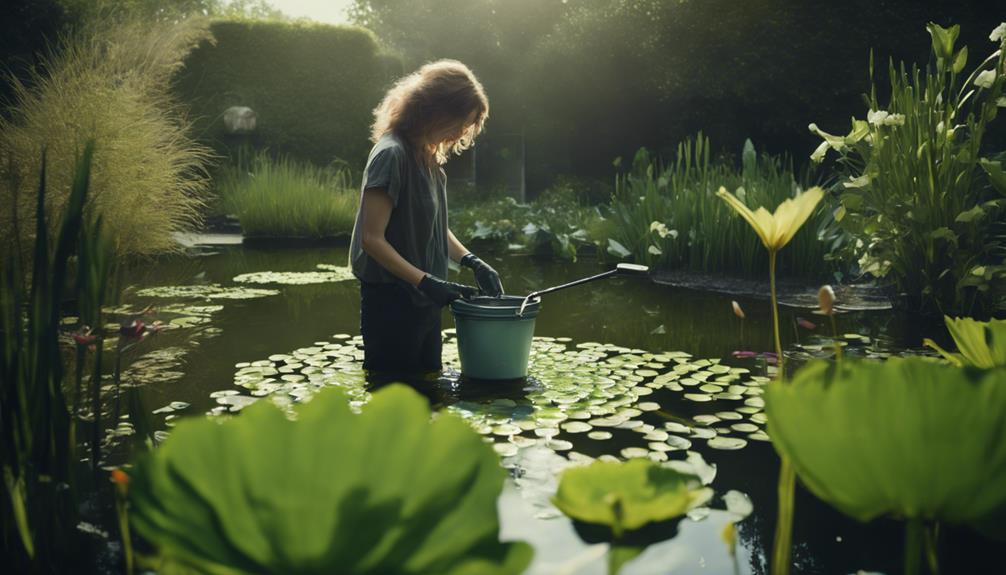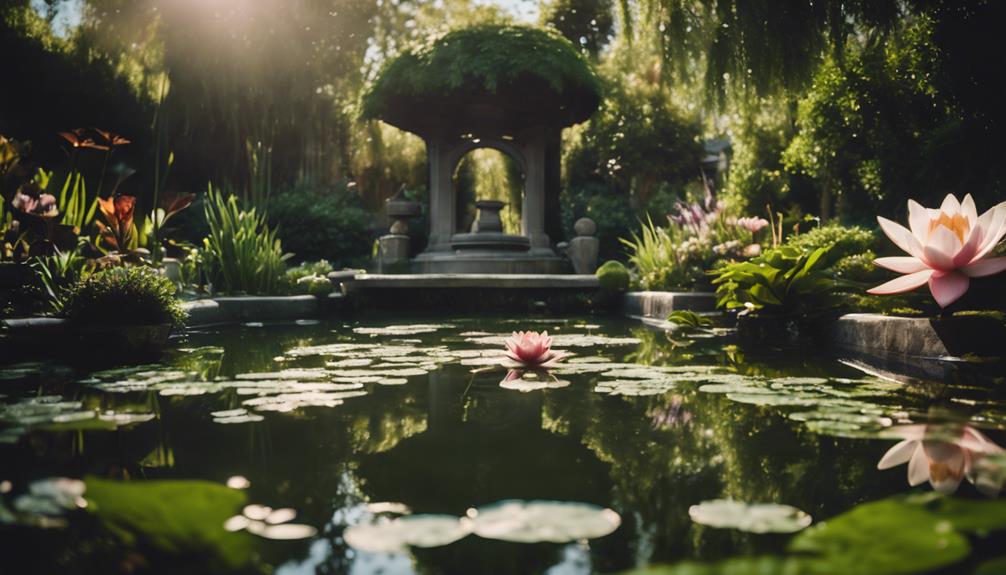To effectively control algae growth in your small garden pond, you'll want to focus on managing excess nutrients, balancing nutrient levels naturally, and utilizing biological augmentation. Improve water circulation by installing a pond pump and incorporating natural filtration systems. Consider adding barley straw to prevent algae growth, and introduce algae-eating organisms safely. Limit sunlight exposure by using shade-providing plants or pond dye. Regular maintenance is key, so be sure to monitor water parameters, perform partial water changes, and inspect filters regularly. By combining these strategies, you'll be well on your way to a healthy, algae-free pond – and there's more to discover to guarantee long-term success.
Table of Contents
Key Takeaways
- Maintain a 10-15 foot buffer zone around the pond or lake to reduce nutrient runoff and algae growth.
- Use lanthanum-modified clay to permanently remove phosphorus from the water column and lock it in the muck on the pond's bottom.
- Introduce algae-eating organisms like fish, safely and at a rate of 1-2 inches per square foot of pond surface area, to consume excess algae.
- Install a pond pump solution that increases oxygen levels and circulates at least half of the pond's water volume every hour to prevent stagnation.
- Incorporate natural filtration systems like submerged plants, floating plants, or biological filters to absorb excess nutrients and encourage beneficial bacteria growth.
Limit Excess Nutrients Entering Water
To prevent algae growth, you can take steps to limit excess nutrients from entering the water by addressing the sources of pollution around your lake or pond.
One vital step is to keep grass clippings, leaves, fertilizer, and other nutrient-loaded organic debris out of the water. This prevents excess nutrients from entering the water, which can fuel algae growth.
Additionally, maintaining a 10-15 foot buffer zone around your pond or lake can substantially reduce nutrient runoff and the risk of algae growth.
You can achieve this by limiting mowing around the edges of your lake or pond, allowing beneficial vegetation to establish a protective buffer. Planting aquatic plants like pickerelweed, sedges, and rushes can also help stabilize the bank, reduce erosion areas, and absorb excess nutrients.
Balance Nutrient Levels Naturally
You can take a more proactive approach to balancing nutrient levels by leveraging natural methods that target the root causes of algae growth.
One vital element to focus on is phosphorus, the primary limiting nutrient in the proliferation of nuisance and harmful algal blooms.
To prevent algae growth, you can use natural methods that reduce phosphorus levels in the pond water.
Use lanthanum-modified clay: This natural solution can permanently remove phosphorus from the water column and lock all available phosphorus in the muck on the pond's bottom.
Incorporate aquatic plants: Plants like pickerelweed, sedges, and rushes can absorb nutrients and reduce erosion areas, promoting ecological balance.
Establish a protective vegetative buffer: This helps reduce erosion areas and keeps nutrients from entering the waterbody, promoting a natural balance of nutrient levels.
Biological Augmentation for Algae Control

By leveraging biological augmentation, pond owners can harness the power of naturally occurring microbes and enzymes to maintain healthy water ecosystems and prevent algae growth.
This approach substantially improves pond water quality by utilizing these micro-organisms to aid in the maintenance of healthy water ecosystems.
By dosing these beneficial bacteria, you boost the natural populations in your pond, helping to further reduce the accumulation of nutrients and organic sludge.
This, in turn, removes the primary food source for algae blooms, promoting healthy water quality.
Biological augmentation helps to balance nutrient levels in your pond by breaking down organic matter and consuming excess nutrients, thereby preventing algae growth.
As a natural and effective way to control the growth of algae, biological augmentation is an essential component of a thorough algae control strategy.
Improve Water Circulation Methods
When you're looking to improve water circulation in your pond, you'll want to ponder installing a pond pump solution that increases oxygen levels.
By doing so, you'll be creating an environment that's less conducive to algae growth, as stagnant water is a prime breeding ground for these unwanted organisms.
Pond Pump Solutions
How can you effectively harness the power of pond pumps to improve water circulation and prevent algae growth in your pond?
By installing a pond pump, you can increase water circulation, which helps prevent stagnant water that creates a favorable environment for algae growth. This, in turn, improves oxygen levels and reduces the risk of algae blooms.
Size matters: Choose a pond pump that can circulate at least half of your pond's water volume every hour.
Proper placement is key: Position the intake valve near the bottom of the pond to draw in nutrient-rich water, and the outlet valve near the surface to distribute oxygen-rich water.
Regular maintenance is vital: Clean the intake valve and replace worn or damaged parts as needed to confirm your pond pump continues to function effectively.
Increase Oxygen Levels
Increase Oxygen Levels
You can increase oxygen levels in your pond by incorporating additional water circulation methods that work in tandem with your pond pump. This is vital for controlling algae growth, as low dissolved oxygen levels create an ideal environment for algae to thrive. By increasing oxygen levels, you'll promote the growth of aerobic bacteria, which produce oxygen and help break down organic matter.
Some effective water circulation methods worth exploring:
| Method | Description | Benefits |
|---|---|---|
| Water Features | Add a fountain, waterfall, or bubbler to increase water movement | Increases oxygen levels, adds visual appeal |
| Aeration Systems | Install an aeration system to inject oxygen into the water | Boosts dissolved oxygen levels, improves water quality |
| Water Circulation Pumps | Use a pump to circulate water from the bottom of the pond to the surface | Increases oxygen levels, reduces stagnation |
| Diffusers | Add a diffuser to release oxygen into the water | Increases dissolved oxygen levels, supports aquatic life |
Utilize Natural Filtration Systems

By incorporating natural filtration systems into your pond or aquarium management, you can harness the power of beneficial bacteria and other microorganisms to break down organic matter and control algae growth.
This environmentally friendly approach is a crucial component of effective pond maintenance, as it allows you to create a balanced ecosystem that's less susceptible to algae blooms.
Submerged plants: These plants, such as anacharis or cabomba, absorb excess nutrients from the water, out-competing algae for resources. They also provide a habitat for beneficial bacteria to thrive.
Floating plants: Plants like water hyacinth or water lettuce float on the surface, shading the water and reducing algae growth. They also absorb excess nutrients, further limiting algae's ability to thrive.
Biological filters: These filters encourage the growth of beneficial bacteria, which break down organic matter and excess nutrients, reducing the likelihood of algae blooms.
Add Barley Straw for Algae Prevention
You can incorporate barley straw into your pond or aquarium management as a natural and environmentally friendly method to prevent algae growth.
This method is effective because barley straw releases compounds that inhibit algae reproduction when it decomposes. It's a long-term solution, lasting up to six months, and takes a few weeks to become effective.
For ideal results, use barley straw in ponds with low to moderate algae growth, as it may not be as effective in ponds with high algae levels or rapid water flow.
To get started, use 1-2 bales of barley straw per acre of pond surface area, and loosely pack it to allow for water circulation.
This method is safe for your aquatic ecosystem, as it doesn't harm fish, plants, or other organisms.
Introduce Algae-Eating Organisms Safely

In addition to using barley straw, introducing algae-eating organisms to your garden pond can provide a complementary approach to controlling algae growth, as these organisms can effectively consume excess algae and reduce the risk of blooms.
To guarantee their success, it's vital to research and choose species that are compatible with your garden's ecosystem and water conditions. This will help create a favorable environment for them to thrive and effectively control algae growth.
Choose the right species: Select algae-eating organisms that are suitable for your pond's size and type of algae. For example, grass carp and koi fish are effective against filamentous algae, while trumpet snails and freshwater shrimp are better suited for controlling green water algae.
Introduce them at the right rate: Add algae-eating organisms at a rate of 1-2 inches of fish per square foot of pond surface, or 1-5 snails or shrimp per square foot.
Monitor and adjust water conditions: Regularly check your pond's water conditions and make adjustments as needed to guarantee the algae-eating organisms can thrive and effectively help control algae growth in your small garden.
Manage Sunlight Exposure Effectively
To effectively control algae growth, it's essential that you limit the amount of sunlight that reaches your pond's water, as algae require prolonged periods of direct sunlight to thrive.
By managing sunlight exposure, you can substantially reduce algae growth in your small garden pond.
One effective way to achieve this is by incorporating shade-providing plants like water lilies and lotus, which can reduce sunlight penetration and create a more balanced ecosystem.
Aim to shade at least 30% to 50% of your pond's surface area to effectively reduce algae growth.
You can also use a pond dye to block sunlight from penetrating the water.
Additionally, strategically placing aquatic plants like cattails or rushes around the pond's perimeter can help achieve partial shade.
By taking these steps, you'll be able to limit the 4-6 hours of direct sunlight algae need to grow, making it much harder for them to thrive.
Regular Pond Maintenance Essentials

Regularly monitoring and adjusting water parameters, such as pH, ammonia, and nitrite levels, becomes a crucial aspect of pond maintenance, as it helps prevent algae growth and guarantees a healthy ecosystem.
By doing so, you'll be able to identify potential issues before they escalate, ensuring your pond remains a thriving haven for your aquatic life.
Remove phosphorus: Regularly test your pond water for phosphate levels and take steps to remove excess phosphorus, which can contribute to algae growth.
Perform partial water changes: Replace 10-20% of your pond water every week to remove excess nutrients and prevent algae blooms.
Inspect and clean filters regularly: Make sure your pond filters are operating efficiently by inspecting and cleaning them regularly, which will help remove waste and excess nutrients that can contribute to nutrient accumulation.
Frequently Asked Questions
What Is the Best Method to Control Algae?
You'll find the best method to control algae by combining algae prevention strategies, monitoring systems, and identifying growth factors, species, and bloom prevention techniques, while regularly testing your water to guarantee a balanced ecosystem.
How Do I Get Rid of Algae in My Garden?
You're not alone – 70% of garden owners struggle with algae growth! To get rid of algae in your garden, focus on prevention through regular maintenance, incorporating eco-friendly solutions like aquatic plants, and optimizing water features to enhance pond aesthetics.
What Kills Algae Naturally?
You can eliminate algae naturally with remedies like barley straw, algae-eating organisms, and beneficial bacteria, which are organic solutions that target biological controls, considering environmental factors, as a safer alternative to chemical alternatives.
What Kills Algae in Small Ponds?
You'll find that introducing algae-eating fish, maintaining good pond maintenance, and preserving water quality all work together to kill algae in small ponds, while also supporting aquatic life and preventing the need for chemical treatments.
Conclusion
As you've tended to your garden's pond, you've nurtured a delicate ecosystem.
Algae control methods are like pruning shears, carefully trimming away excess to reveal a thriving balance.
By limiting nutrients, balancing levels naturally, and introducing algae-eating organisms, you've orchestrated a harmonious symphony.
Regular maintenance is the conductor's baton, guiding your pond towards clarity and serenity.
With these methods, your pond will shine like a polished mirror, reflecting the beauty of your garden.

